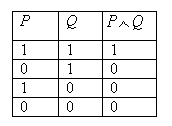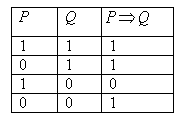| and: | |
| or: | |
| implies: |
Logic is an indispensable part of our daily lives, just as it is an indispensable part of mathematics. Whenever we present a reasoned argument on some topic, and whenever we present a proof of a mathematical fact, we are using logic. In both cases, the logic being used follows exactly the same structures. When used in mathematics, the structure of a logical argument is relatively easy to discern, but when embedded in ordinary language, the logic may not be so readily identifiable. But nonetheless, an understanding of at least the basics of logic is essential both in mathematics and in everyday life.
Symbolic Logic
The use of a symbolic language to represent logical arguments, mathematical or otherwise, can often clarify the logic involved, and help you to determine whether the argument is valid or not. In symbolic logic, a statement (also called a proposition) is a complete declarative sentence, which is either true or false. (Questions, commands and exclamations are not statements, by this meaning.) We use a single letter such as P, Q or R to represent a statement. The truth value of a statement is 1 if the statement is true, and 0 if it is false. For example, as I write this, it is a cloudy day, but it is not raining. So if P is the statement that it is raining, then the truth value of P would be 0. (Of course, there is no way for you to verify the truth value of my statement about the weather.) The truth values of statements used in mathematics, on the other hand, can often be verified. For instance, the truth value of the statement that 2 < 3 is indeed 1.
Compound statements can be built from simple statements, by connecting
them with various logical connectives. The most commonly used
logical connectives are and, or, and implies.
These connectives are often denoted by the following symbols:
| and: | |
| or: | |
| implies: |
For instance, if P and Q are statements, then the compound
statement "P implies Q" would be denoted ![]() ,
while the statement "P and Q" would be denoted
,
while the statement "P and Q" would be denoted ![]() .
.
The connectives above are used to connect one statement to another,
to form a compound statement. Another important "connective" is the
negation
or not connective. Instead of joining two statements,
this applies to a single statement, to create the negation of that statement.
The negation of a statement P is denoted by ~ P. For
example, if P is the statement that it is a cloudy day, then ~ P
is the statement that it is not a cloudy day. If Q
is the statement that 2 < 3, then ~
Q is the statement that ![]() .
.
Truth Tables
The truth value of a compound statement depends on the truth values
of its components. For example, the statement ![]() is
true only if both P and Q are true;
is
true only if both P and Q are true; ![]() is
false in all other cases. This idea can be summarized in a truth
table:
is
false in all other cases. This idea can be summarized in a truth
table:

The truth table for an implication is of special interest, because implications
are used so frequently in both everyday argumentation and in mathematics.
The truth table for ![]() is:
is:

Modus Ponens
Thankfully, the situation just described does not arise very frequently, either in common language or in mathematics. Although some logical arguments can be very complicated, the most common use of logic boils down to the fact that
Modus ponens can be interpreted as follows. If we know that ![]() is true and we know that P is true, then it follows that Q
must be true. This type argument is also referred to as a syllogism,
and can be expressed in symbolic form as:
is true and we know that P is true, then it follows that Q
must be true. This type argument is also referred to as a syllogism,
and can be expressed in symbolic form as:

In this type of argument, there are two premises,![]() (called the major premise) and P (called the minor premise)
and one conclusion, namely Q. Because of modus ponens,
if you agree that both of the premises are true, then you have no choice
but to accept the fact that the conclusion is also true. As an example
taken from common language, consider the argument "If you get your feet
wet, then you will catch a cold. You got your feet wet. Therefore,
you will catch a cold." If you believe the major premise to be a
true statement (if you get your feet wet, then you will catch a cold),
and if you observe that the minor premise is also true (you did, in fact,
get your feet wet), then you must also believe the conclusion -- that you
will, in fact, catch a cold.
(called the major premise) and P (called the minor premise)
and one conclusion, namely Q. Because of modus ponens,
if you agree that both of the premises are true, then you have no choice
but to accept the fact that the conclusion is also true. As an example
taken from common language, consider the argument "If you get your feet
wet, then you will catch a cold. You got your feet wet. Therefore,
you will catch a cold." If you believe the major premise to be a
true statement (if you get your feet wet, then you will catch a cold),
and if you observe that the minor premise is also true (you did, in fact,
get your feet wet), then you must also believe the conclusion -- that you
will, in fact, catch a cold.
Validity
Now you may take issue with the major premise in the argument above, in which case you are not by any means obligated to accept the conclusion. However, the argument -- the use of logic -- is nonetheless perfectly valid. The validity of an argument has to do only with the logical structure of the argument, and not with the truth of any of the premises. Convincing an individual that the premises are, indeed, true is persuasion rather than logic.
As an example of an invalid argument, consider the following: "If you were born in Cleveland, then you are a U.S. citizen. You are a U.S. citizen. Therefore, you were born in Cleveland." The logical structure of this argument is:

Mathematical Proof
Many of the theorems in mathematics are of the form ![]() -- for example, "If f is differentiable,
then
f is continuous." In order to prove such a theorem, we
must prove that the one situation in which the implication has a truth
value of 0 never occurs. (Remember that in the truth table for
-- for example, "If f is differentiable,
then
f is continuous." In order to prove such a theorem, we
must prove that the one situation in which the implication has a truth
value of 0 never occurs. (Remember that in the truth table for ![]() ,
there is only one line where the truth value is 0.) That is,
we must prove that if P is true (has a truth value of 1), then Q
does not have a truth value of 0 (that is, that Q is also true).
Consequently, the beginning of the proof of a mathematical theorem of the
form
,
there is only one line where the truth value is 0.) That is,
we must prove that if P is true (has a truth value of 1), then Q
does not have a truth value of 0 (that is, that Q is also true).
Consequently, the beginning of the proof of a mathematical theorem of the
form ![]() is
always something like: "Suppose that P is true." The remainder
of the proof is then a logical argument (embedded in language, of course)
that Q is also true.
is
always something like: "Suppose that P is true." The remainder
of the proof is then a logical argument (embedded in language, of course)
that Q is also true.
The Converse and the Contrapositive
Every statement of the form ![]() has a converse, namely the implication
has a converse, namely the implication ![]() ,
and a contrapositive, namely the implication
,
and a contrapositive, namely the implication ![]() .
The truth tables for
.
The truth tables for ![]() and
and ![]() do
not match up; that is, there are instances of truth values for P
and Q in which
do
not match up; that is, there are instances of truth values for P
and Q in which ![]() is true and
is true and ![]() is false, and vice versa. As a result, an implication and its converse
are not logically equivalent; that is, they have different meanings.
For instance, the statements "If you get your feet wet, then you will catch
a cold" and "If you catch a cold, you must have gotten your feet wet" are
not equivalent statements.
is false, and vice versa. As a result, an implication and its converse
are not logically equivalent; that is, they have different meanings.
For instance, the statements "If you get your feet wet, then you will catch
a cold" and "If you catch a cold, you must have gotten your feet wet" are
not equivalent statements.
However, the statement ![]() and its contrapositive,
and its contrapositive, ![]() ,
are
logically equivalent; the truth tables for these two statements will show
identical truth values under all four combinations of P and Q
being true or false. As a result, an implication and its contrapositive
are interchangeable as far as logic is concerned. This fact is often
used in mathematics, in cases where a proof of a statement of the form
,
are
logically equivalent; the truth tables for these two statements will show
identical truth values under all four combinations of P and Q
being true or false. As a result, an implication and its contrapositive
are interchangeable as far as logic is concerned. This fact is often
used in mathematics, in cases where a proof of a statement of the form ![]() seems a little easier than a proof of the statement that
seems a little easier than a proof of the statement that ![]() .
.
The Study of Logic
As an academic discipline, logic lies on the boundary between mathematics and philosophy. In philosophy, logic is used whenever a philosopher argues a certain position. (Caution: Such an argument may be perfectly valid, but you may still take issue with the conclusion, depending on whether or not you believe the premises to be true.) In mathematics, of course, logic is used in the proof of every theorem. One important difference between a mathematical argument and a philosophical argument, however, is that -- unlike philosophy -- in mathematics the goal is not to convince you that a certain conclusion is true, but that the entire proposition is true. For example, in the theorem that if f is a differentiable function, then f is also continuous, the goal is not to convince you that f is continuous (the conclusion), but rather that every differentiable function is continuous (the proposition). As a result, any debate or uncertainty about mathematical theorems centers around the validity of the argument itself (which may be extremely complex and lengthy), whereas debate about philosophical arguments often centers around the truth of the premises.
Further Exploration